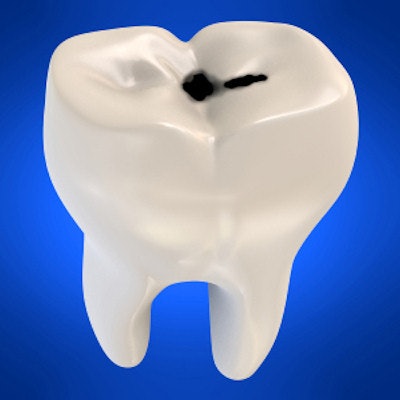
What's the best way to detect and measure caries? What are the pros and cons of some of the newer methods? To provide some answers, researchers from Brazil put three caries detection methods to the test.
They compared results in the same population with the decayed, missing, and filled (DMF) index; the International Caries Detection and Assessment System (ICDAS); and the Caries Assessment Spectrum and Treatment (CAST). The investigators found that the methods varied by the amount of time required for their use and also their thoroughness in distinguishing caries severity and the first clinical signs of caries.
"The DMF underestimated the occurrence of caries lesions in individuals but was the fastest method to apply," the authors wrote (BMC Oral Health, July 6, 2018). "ICDAS obtained detailed information regarding lesion severity but was time-consuming and difficult to analyze. CAST described disease distributions very well and identified lesion severities and preventive and curative needs, and the time required was similar to that of the DMF."
The lead author was Ana Luiza Sarno Castro, PhD, an assistant professor at the State University of Feira de Santana in Bahia, Brazil.
No consensus
There is no consensus regarding the use of criteria or methods for detecting caries, the study authors noted. The DMF index has been used most commonly to detect caries from dentin lesions but has some limitations. Newer, validated methods for measuring caries include the ICDAS and CAST methods.
“CAST described disease distributions very well and identified lesion severities and preventive and curative needs.”
However, little research has been conducted comparing methods for measuring caries in adult populations. Therefore, the researchers sought to examine the ability of these three methods to determine the extent and severity of caries.
The DMF index has been used for 80 years and is considered the key measure of caries experience. The CAST method uses 10 codes arranged hierarchically that allow for the measurement of lesions in enamel and three levels of lesions in dentin. It is the only method that distinguishes lesions with morbidity and severe morbidity that reach the tooth pulp. The ICDAS method requires observation of a tooth surface after drying, and it uses one digit to indicate fillings and sealants and a second digit for caries lesions.
The current study involved the use of the three methods in the same group of patients by four examiners. The examiners underwent 18 hours of training in each of the methods.
The study population was composed of 260 adult students, employees, and family members who used the dental service at the State University of Bahia during a three-month period.
Each patient underwent three exams during the same session performed by different examiners using each of the three methods. Each exam included 128 surfaces of 28 permanent teeth. The examiners counted surfaces with sealants as healthy.
Re-examinations were done in 10% of the patients to compare intra- and interexaminer reproducibility. A good level of agreement within and between examiners was reported.
The DMF method was the fastest and produced the most heterogeneous results. The CAST method took a minute longer to perform but had the least heterogeneous data. The ICDAS method, meanwhile, took much longer than the other two methods, with a coefficient of variation slightly higher than CAST.
| Performance time & coefficient of variation by method | |||
| Method | CAST | DMF | ICDAS |
| Mean minutes | 4.7 | 3.8 | 8.9 |
| Time range (minutes) | 1.5 to 7.0 | 1.2 to 8.2 | 3.3 to 18.0 |
| Coefficient of variation | 29.8% | 39.5% | 31.5% |
The investigators determined caries presence in the population according to the indicator of the most severe caries lesion per individual. Using the DMF yielded a prevalence of 28.1%. However, caries prevalence was 84.6% with ICDAS and 75% with CAST.
The methods varied in the percentage of examined teeth classified as healthy:
- DMF: 77.9%
- CAST: 66.8%
- ICDAS: 59.1%
The researchers found that the DMF was simple to perform and its analysis was straightforward, and they also reported no difficulties with its use and analysis of the CAST method. However, the authors questioned the usefulness of the ICDAS method, since many of these surfaces later revert to health without treatment.
Limitations of the methods
The authors ultimately deemed CAST ideal for caries detection, DMF less useful for health planning but quick and simple for when measurement of enamel lesions is unnecessary, and ICDAS difficult to use for epidemiological surveys but more appropriate for clinical studies and individual caries lesion evaluations.
"This result demonstrated that more detailed methods, including enamel lesions and various codes for dentine lesions, do not diminish reproducibility provided that a good calibration of the examiners is performed," the authors concluded.



















